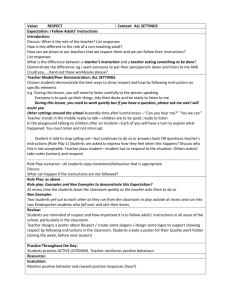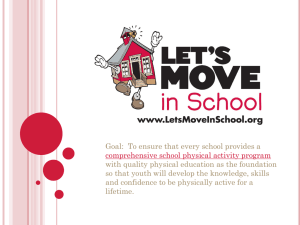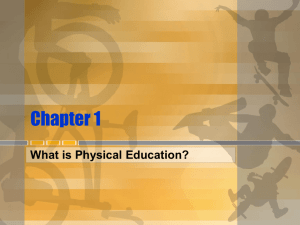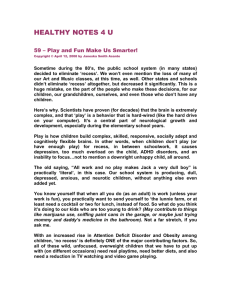CSPAP for 4650 - tblanfo1
advertisement
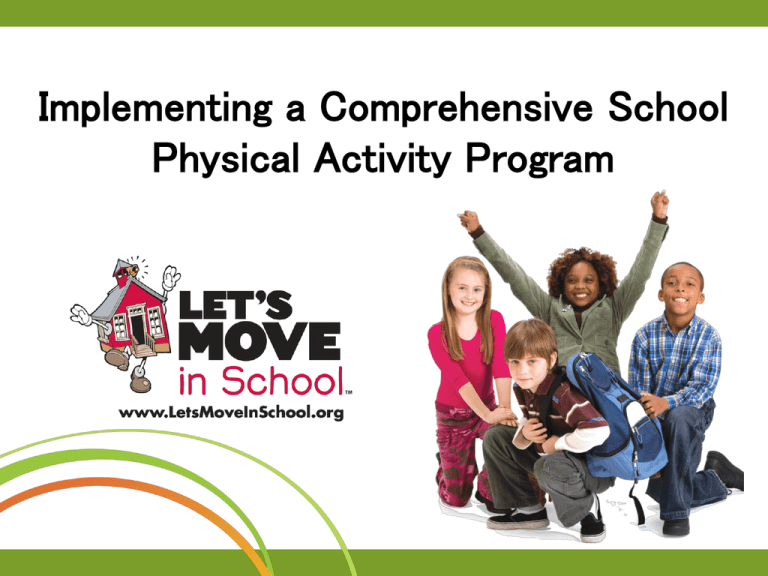
Implementing a Comprehensive School Physical Activity Program Let’s Move in School • The American Alliance for Health, Physical Education, Recreation and Dance (AAHPERD) supports the goal of First Lady Michelle Obama’s Let’s Move! Campaign • Pledges to give teachers, principals, superintendents, school boards, and parents the support they need to help our students to become more physically educated and active in school Let’s Move in School Goal • To ensure that every school provides a comprehensive school physical activity program with quality physical education as the foundation so that youth will develop the knowledge, skills and confidence to be physically active for a lifetime What is a CSPAP? • Comprehensive School Physical Activity Program (CSPAP) • School districts and schools utilize all opportunities for school-based physical activity • Develop physically educated students who participate in the nationally-recommended 60+ minutes of physical activity each day • Develop the knowledge, skills, and confidence to be physically active for a lifetime CSPAP Goals • Enable all students to participate in at least 60 minutes of moderate-tovigorous physical activity each day • Provide coordination among the CSPAP components to maximize knowledge and skills learned in physical education so that all students will be fully physically educated and well-equipped for a lifetime of physical activity Why Implement a CSPAP? • Evidence shows that physically active students have better learning readiness, attention, fewer behavior issues, and ultimately better academic outcomes. (CDC. The association between school based physical activity, including physical education, and academic performance. Atlanta, GA: U.S. Department of Health and Human Services; 2010.) • Children and adolescents need 60 minutes or more of physical activity each day. (CDC. Physical Activity for Everyone; http://www.cdc.gov/physicalactivity/everyone/guidelines/children.html.) • Approximately 17% (or 12.5 million) of children and adolescents aged 2-19 years are obese. (From: www.cdc.gov/obesity/data/trends.html; data from the National Health and Examination Survey (NHANES).) They are more likely than youth of normal weight to become overweight or obese adults. (From: www.cdc.gov/healthyyouth/obesity/index.htm; citation: U.S. Surgeon General. Overweight and Obesity: Health Consequences. Rockville: MD; 2001.) Obesity Trends* Among U.S. Adults BRFSS, 1990, 1999, 2009 (*BMI 30, or about 30 lbs. overweight for 5’4” person) 1999 1990 2009 No Data <10% 10%–14% 15%–19% 20%–24% 25%–29% ≥30% How Much Movement? NASPE Guidelines for Children How Active Should They Be? Physical Activity Guidelines for Children Ages 5 – 12 1. Children should accumulate at least 60 minutes, and up to several hours, of age-appropriate physical activity on all, or most days of the week. 2. Children should participate in several bouts of physical activity lasting 15 minutes or more each day. NASPE Guidelines continued. . . . 3. Children should participate each day in a variety of age-appropriate physical activities designed to achieve optimal health, wellness, fitness, and performance benefits. 4. Extended periods (periods of two hours or more) of inactivity are discouraged for children, especially during the daytime hours. Development of the Whole Child The Importance of Physical Activity Reasons for Movement 1. The shape of our nation 2. Movement enhances learning 3. Development of the whole child Academic Research Overview Poor nutrition and lack of physical activity result in: – increased absenteeism; – low energy; – low self-esteem; – difficulty concentrating; and – lower academic achievement. 1. (Action for Healthy Kids, 2004) 2. Grissom, J. B. (2005). Physical fitness and academic achievement. Journal of Exercise Physiology, 8(1), 11-25. 3. Ratey, J. (2008). Spark: The revolutionary new science of exercise and the brain. Academic Research Overview Centers for Disease Control and Prevention (CDC) Review of Research Findings – 50 studies reviewed – A total of 251 associations between physical activity and academic performance were tested – More than half (50.5%) of all associations tested were positive – Only 4 (1.5%) of all associations tested were negative Full report of methods and results: www.cdc.gov/HealthyYouth Breaking Down the CSPAP Components Physical Education • Implement a standards-based curriculum that includes a clear scope and sequence • Identify clear objectives (i.e., psychomotor, cognitive, and affective) for each physical education lesson • Provide instruction in a wide variety of skills related to sport, lifetime activities, and fitness Physical Activity During the School Day • Include a healthy living tip or quote as part of each morning’s announcements • Provide short physical activity breaks during long stretches of seated instruction • Provide all secondary school students with drop-in recess activities so they can be active during their lunch or free periods Physical Activity Before and After School • Create safe opportunities for students to walk and bike to school in collaboration with parents and community organizations • Open and supervise physical activity facilities for staff and student use before and after school • Organize physical activity clubs and intramural sports to encourage physical activity participation by students of all abilities Staff Involvement • Conduct a staff needs assessment to identify health-related needs and work with local organizations to address those needs • Hold walk and talk meetings with colleagues • Provide staff professional development on creating opportunities for physical activity in the classroom Family and Community Involvement • Include physical education and physical activity information on the school website and in each school newsletter • Invite community participation in special events • Teach students how to use community physical activity resources Question • Is your school district already implementing or supporting any of the CSPAP components? How Can We Get Started? • Begin by looking at the CSPAP model and asking: “Are we allowing students every opportunity to be physically active from the moment they walk in the door to the moment they leave the building?” Comprehensive School-Based Physical Activity Program Commitment from School Personnel Comprehensive School-Based Physical Activity Program Coordinated effort requiring in- and out-ofschool programming Stakeholders • • • • • • • Administrator(s) Physical Education Teacher(s) Classroom Teachers School Nurse Community Leaders Parents Students How Do We Keep Going? • Recognize that it will take time to implement a CSPAP • Engage partners and supporters • Take one step at a time • Celebrate your successes! PE vs. PA Physical Education - the instructional program designed to teach national and state standards and to develop physically educated individuals who have the knowledge, skills, and confidence to enjoy a lifetime of physical activity Physical Activity - bodily movement that substantially increases energy expenditure Quality Physical Education • Provides: – – – – Learning opportunities Appropriate instruction Meaningful and challenging content Student and program assessment • Improves: – Physical skills and abilities – Physical fitness – Readiness and enthusiasm for learning – Academic performance – Mental alertness – Overall health Opportunity to Learn • All students required to take physical education • Instructional periods total 150 minutes per week (elementary) and 225 minutes per week (secondary) • Physical education class size consistent with that of other subject areas • Qualified physical education specialist and adapted physical education specialist provides a developmentally appropriate program • Adequate and safe equipment and facilities Meaningful Content • Written, sequential curriculum for grades P-12, based on state or national standards • Instruction in a variety of motor skills designed to enhance the physical, mental, and social/emotional development of every child • Fitness education and assessment to help children understand, improve and/or maintain physical well-being Meaningful Content • Development of cognitive concepts about motor skill and fitness • Opportunities to improve emerging and cooperative skills and gain a multi-cultural perspective • Promotion of regular amounts of appropriate physical activity now and throughout life Appropriate Instruction • Full inclusion of all students • Maximum practice opportunities for class activities • Well-designed lessons that facilitate student learning • Out of school assignments that support learning and practice • Physical activity not assigned as or withheld as punishment • Regular assessment to monitor and reinforce student learning © 2011 Sandy "Spin" Slade, Inc. Skillastics® Student and Program Assessment • Assessment is an on-going, vital part of the program • Formative and summative assessment of student progress • Student assessments aligned with state/national physical education standards and the curriculum • Assessment of program elements that support quality physical education • Stakeholders periodically evaluate the total physical education program effectiveness Why is QPE Important? • Helps all students develop: – Health-related fitness – Physical competence – Cognitive understanding – Positive attitudes about physical activity so they can adopt healthy and physically active lifestyles Physical Activity During School Physical Activity During School • Recess • Classroom-based physical activity breaks • Physical activity integrated into classroom lessons • Drop-in physical activity opportunities Recess What is Recess? Recess is unstructured but purposeful break time during the school day that allows kids to engage in physical activity and social development All children should engage in at least one daily period of recess for at least 15-20 minutes per period Scheduling and Planning Recess • Recess should be outdoors if weather is above freezing. If inclement weather prevents recess, indoor movement and social breaks should be the replacement • Recess is not scheduled immediately before or after physical education class • Recess does not interfere with physical education classes that are taking place in a common environment Supervision at Recess • Recess should be properly supervised by adults • Adults should intervene only when a child’s physical or emotional safety is an issue Promoting Physical Activity at Recess • Adequate, safe, and developmentally appropriate equipment is provided for students to engage in enjoyable physical activity (balls, ropes, etc.) • Adequate, safe spaces and facilities are provided for all students to be physically active at the same time Promote Physical Activity at Recess Teach low organization games children can play on their own – – – – – – – – – Four Square Hopscotch Different versions of Kickball Horse, Around the World, etc. Wall Ball, Tetherball, etc. Tag games Long Rope Jumping Challenges Short Rope Jumping Challenges Recess Activities of the Week (RAW) Promoting Physical Activity at Recess Recess is not viewed as a reward but as a necessary educational support component for all children Students should not be denied recess so they can complete class work or as a means of punishment Recess • At least 20 minutes per day for all elementary students • Do not withhold recess for disciplinary reasons • Variety of equipment • Active supervision • Peaceful Playgrounds www.peacefulplaygrounds.com Classroom-based PA breaks • Start the day with an all-school “Wake-up/Warm-up” activity • Provide short 5-10 minute physical activity breaks during long stretches of seated instruction • Take students outside for a walk before a test • Skillastics® www.skillastics.com PA Integrated into Classroom Instruction • Provide kinesthetic learning opportunities – building, experiencing, touching, collecting, etc. • Create lessons that require students to stand or move in the classroom • Energy Balance 101 www.energybalance101.com Drop-in Physical Activity • Provide secondary students with drop-in recess activities so they can be active during lunch and free periods • Provide physical activity themed assemblies © 2011 Sandy "Spin" Slade, Inc. Skillastics® Resources • • • • Peaceful Playgrounds www.peacefulplaygrounds.com Skillastics® www.skillastics.com Energy Balance 101 www.energybalance101.com Integrating Physical Activity into the Complete School Day http://www.aahperd.org/naspe/publications/teachingTools/uplo ad/PA-During-School-Day.pdf • Brain Breaks http://www.emc.cmich.edu/BrainBreaks/ • Maximizing Recess Physical Activity http://www.pelinks4u.org/articles/Beighle0610.htm • JAMmin’ Minutes http://www.jamschoolprogram.com/ Staff Involvement Staff Involvement • Staff wellness program • Professional development • Physical activity opportunities with students Staff Wellness Program • Physical activity opportunities for staff • Nutrition education • Conduct a staff needs assessment • Offer incentives Professional Development • Brain breaks during staff meetings • Physical activity in the classroom training • Staff who supervise recess Physical Activity Opportunities with Students • School-wide field day • 5K run/walk event(s) • Active transport programs • Positive role models • Joint-use agreements Sample Healthy Initiatives o Group Fitness Classes o o o o Zumba Pilates Dance Boot Camp o Physical Activity Teams o Weight Watchers o Weight and Blood Pressure Checks; CPR Training Resources • School employee wellness – http://www.schoolempwell.org/ • Good Work! Resource Kit – http://www.healthymainepartnerships.org/goodwork-resourcekit.aspx • Healthy Arkansas Worksite Wellness Toolkit – http://www.acsworkplacesolutions.com/ • CDC Healthier Worksite Initiative – http://www.cdc.gov/nccdphp/dnpao/hwi/index.htm • Comprehensive Guide to Worksite Wellness – http://www.wellnessproposals.com/wellness_proposals_guide_to_wo rksite_wellness.htm Family and Community Involvement Comprehensive School-Based Physical Activity Program Physical Activity and the Community Family game night Share facilities Nutrition and physical activity seminars Newsletters, websites, emails Physical activity at home Special initiatives Summer camp Local partnerships Guest speakers Fundraisers Community outreach Can We Implement a CSPAP?
